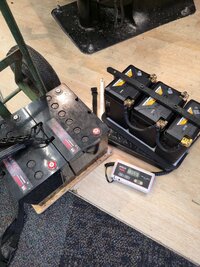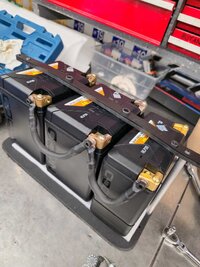gmtech16450yz
Jetboaters Captain
- Messages
- 291
- Reaction score
- 566
- Points
- 217
- Location
- SF Bay Area
- Boat Make
- Yamaha
- Year
- 2017
- Boat Model
- Limited S
- Boat Length
- 21
Since I have Lifepo4 batteries in most everything else I own, I figured it was time to put them in our boat. One of my issues in the boat has been the voltage on regular lead acid (AGM) batteries is so low that I usually have to start one or both of the engines to use my electric anchor winch.
So I picked up a pair of NOCO NLP30's and I already had a NLP20 I wasn't using in anything. I'm using the two NLP30's as the house battery and the single NLP20 as the start battery. Any one of these batteries will start a V8 with no problem, the NLP20's have been working fine in our Yamaha SVHO skis. The reserve capacity of even the two NLP30's wouldn't work for those of you who use your stereo when sitting, which we don't. For us, running the Simrad Go9, the audio amp (for phone notifications through bluetooth), the marine radio and the occasional bilge pump running, we can sit for over 5 hours on those two house batteries. Not a big deal even if the house battery is run all the way down, the start battery will still be at 100%.
The benefits? The first is power. The two group 24 AGM's I had in there put out 1050cca when combined. The three Lifepo4's put out 1,900 cca. The cranking voltage of the AGM's was 10.9 volts. The cranking voltage of the Lifepo4's is 12.4 volts. That's a difference you can clearly tell when the engines are cranking up. So way more amperage and voltage.
The second is the weight. The two AGM's on a mounting pad was 115 pounds. The Lifepo4's on a mounting pad, with jumper cables on, weighs 15.5 pounds! That's a significant weight reduction. Again, this is something that the wake surfing guys won't want to do. We don't wake surf.
The only electrical system mod I had to do was to remove the dvsr. Lithium batteries sit at around 13.6 volts not being charged, that will turn the dvsr on all the time. I used a continuous use solenoid as a battery combiner. I ran ignition signal wires from each engine, through two diodes to trigger the solenoid. So whenever the engines get ignition power, the batteries are combined. That means they always use all three batteries for starting, that's a good thing.
(BTW, for those of you that have tapped off of the fuel pump or ignition circuit to control your dvsr, realize that you will only combine the batteries off that ONE engine. To combine the batteries with the dvsr or a solenoid like I did, you have to pull a fuel pump or ignition signal from BOTH engines. You also have to separate them with diodes so they don't backfeed each other. We often run on one engine for trolling so I needed to have either engine initiate battery charging.)
Pics of course...


So I picked up a pair of NOCO NLP30's and I already had a NLP20 I wasn't using in anything. I'm using the two NLP30's as the house battery and the single NLP20 as the start battery. Any one of these batteries will start a V8 with no problem, the NLP20's have been working fine in our Yamaha SVHO skis. The reserve capacity of even the two NLP30's wouldn't work for those of you who use your stereo when sitting, which we don't. For us, running the Simrad Go9, the audio amp (for phone notifications through bluetooth), the marine radio and the occasional bilge pump running, we can sit for over 5 hours on those two house batteries. Not a big deal even if the house battery is run all the way down, the start battery will still be at 100%.
The benefits? The first is power. The two group 24 AGM's I had in there put out 1050cca when combined. The three Lifepo4's put out 1,900 cca. The cranking voltage of the AGM's was 10.9 volts. The cranking voltage of the Lifepo4's is 12.4 volts. That's a difference you can clearly tell when the engines are cranking up. So way more amperage and voltage.
The second is the weight. The two AGM's on a mounting pad was 115 pounds. The Lifepo4's on a mounting pad, with jumper cables on, weighs 15.5 pounds! That's a significant weight reduction. Again, this is something that the wake surfing guys won't want to do. We don't wake surf.
The only electrical system mod I had to do was to remove the dvsr. Lithium batteries sit at around 13.6 volts not being charged, that will turn the dvsr on all the time. I used a continuous use solenoid as a battery combiner. I ran ignition signal wires from each engine, through two diodes to trigger the solenoid. So whenever the engines get ignition power, the batteries are combined. That means they always use all three batteries for starting, that's a good thing.
(BTW, for those of you that have tapped off of the fuel pump or ignition circuit to control your dvsr, realize that you will only combine the batteries off that ONE engine. To combine the batteries with the dvsr or a solenoid like I did, you have to pull a fuel pump or ignition signal from BOTH engines. You also have to separate them with diodes so they don't backfeed each other. We often run on one engine for trolling so I needed to have either engine initiate battery charging.)
Pics of course...


Last edited:
